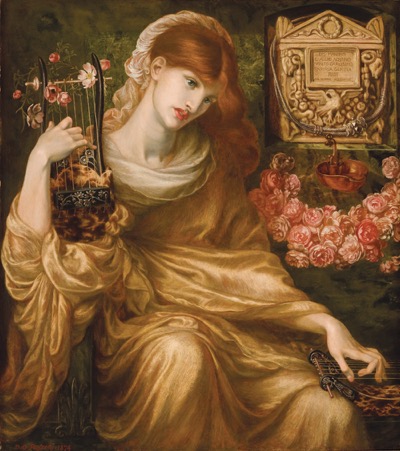In Rossetti’s Roman widow, he based the marble cinerary on one he owned himself, which he copied from Pompey’s mural paintings. A widow plays two instruments as she expresses her sorrow in her husband’s honour. He painted her sitting beside the urn containing her husband’s ashes.
He reflects a tour de force as the magnificent array of shades of white. We can interpret this exhibition of painting techniques as Dante Gabriel Rossetti’s attempt to counter Alma-Tadema, a talented artist who had become famous for his representation of white marble. The attention to archaeological details corresponds to the new classicism of Alma Tadema's fashion. He based the silver wedding girdle, white mourning draperies, and the musical instruments on archaeological materials. Rosetti painted in oils with watercolour brushes, on canvas which he had primed with white till the surface was a smooth as cardboard and all the stones remain transparent. In this painting, he showed a mixture of genius and intuition.
The Roman widow related in particular to the strict aphorism of Flowval, written in 1880 after Dante Gabriel Rossetti had read about Flaubert’s death. This painting is important because of the strange and implicit relationships between the other works of Dante Gabriel Rossetti from 1872 to 1877, in particular, La Ghirlandata, Veronica Veronese and A Sea Spell. Many people often consider Rossetti a mediaevalist like his friends William Morris and Burne-Jones and not as a classic as Lord Leiden or Lawrence Alma-Tadema. However, his subjects were amazing and came from classic materials. He also used Latin at school often to in his headings and inscriptions.
In 1848, he founded the Pre-Raphaelite Brotherhood with John Everett Millais and William Holman Hunt. Later, Rossetti became the main inspiration for the second generation of artists and writers affected by the movement, including Edward Burne Jones and William Morris. His works were the main pioneers of the aesthetic movement and have also influenced European symbolists. He is not only recognised as a painter but also a poet, illustrator, and translator. Today, we locate the Roman widow at the Museo de Arte de Ponce, in Ponce, Puerto Rico. One can also find here a collection of both Puerto Rican and European arts. The museum boasts of important Pre-Raphaelite collections in the Western Hemisphere, with approximately 4,500 works of art in 14 galleries.




